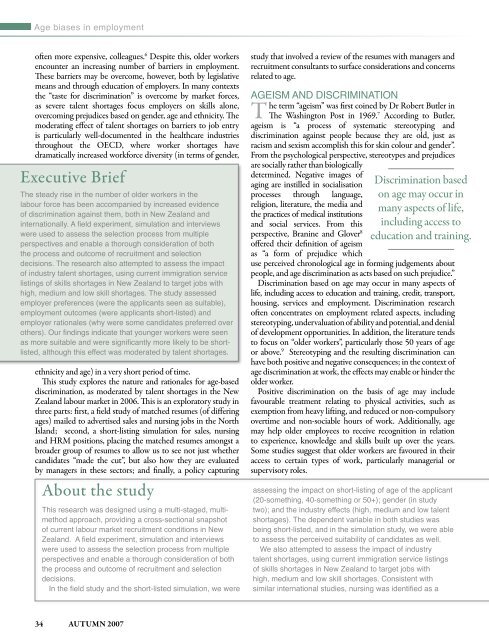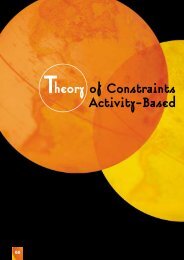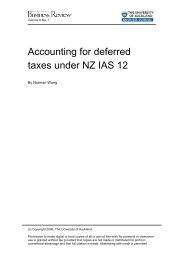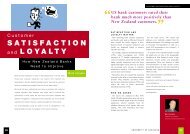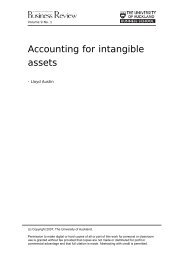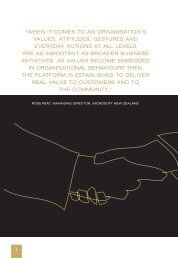Age biases in employment: - University of Auckland Business Review
Age biases in employment: - University of Auckland Business Review
Age biases in employment: - University of Auckland Business Review
- No tags were found...
Create successful ePaper yourself
Turn your PDF publications into a flip-book with our unique Google optimized e-Paper software.
<strong>Age</strong> <strong>biases</strong> <strong>in</strong> <strong>employment</strong><strong>of</strong>ten more expensive, colleagues. 6 Despite this, older workersencounter an <strong>in</strong>creas<strong>in</strong>g number <strong>of</strong> barriers <strong>in</strong> <strong>employment</strong>.These barriers may be overcome, however, both by legislativemeans and through education <strong>of</strong> employers. In many contextsthe “taste for discrim<strong>in</strong>ation” is overcome by market forces,as severe talent shortages focus employers on skills alone,overcom<strong>in</strong>g prejudices based on gender, age and ethnicity. Themoderat<strong>in</strong>g effect <strong>of</strong> talent shortages on barriers to job entryis particularly well-documented <strong>in</strong> the healthcare <strong>in</strong>dustriesthroughout the OECD, where worker shortages havedramatically <strong>in</strong>creased workforce diversity (<strong>in</strong> terms <strong>of</strong> gender,Executive BriefThe steady rise <strong>in</strong> the number <strong>of</strong> older workers <strong>in</strong> thelabour force has been accompanied by <strong>in</strong>creased evidence<strong>of</strong> discrim<strong>in</strong>ation aga<strong>in</strong>st them, both <strong>in</strong> New Zealand and<strong>in</strong>ternationally. A field experiment, simulation and <strong>in</strong>terviewswere used to assess the selection process from multipleperspectives and enable a thorough consideration <strong>of</strong> boththe process and outcome <strong>of</strong> recruitment and selectiondecisions. The research also attempted to assess the impact<strong>of</strong> <strong>in</strong>dustry talent shortages, us<strong>in</strong>g current immigration servicelist<strong>in</strong>gs <strong>of</strong> skills shortages <strong>in</strong> New Zealand to target jobs withhigh, medium and low skill shortages. The study assessedemployer preferences (were the applicants seen as suitable),<strong>employment</strong> outcomes (were applicants short-listed) andemployer rationales (why were some candidates preferred overothers). Our f<strong>in</strong>d<strong>in</strong>gs <strong>in</strong>dicate that younger workers were seenas more suitable and were significantly more likely to be shortlisted,although this effect was moderated by talent shortages.ethnicity and age) <strong>in</strong> a very short period <strong>of</strong> time.This study explores the nature and rationales for age-baseddiscrim<strong>in</strong>ation, as moderated by talent shortages <strong>in</strong> the NewZealand labour market <strong>in</strong> 2006. This is an exploratory study <strong>in</strong>three parts: first, a field study <strong>of</strong> matched resumes (<strong>of</strong> differ<strong>in</strong>gages) mailed to advertised sales and nurs<strong>in</strong>g jobs <strong>in</strong> the NorthIsland; second, a short-list<strong>in</strong>g simulation for sales, nurs<strong>in</strong>gand HRM positions, plac<strong>in</strong>g the matched resumes amongst abroader group <strong>of</strong> resumes to allow us to see not just whethercandidates “made the cut”, but also how they are evaluatedby managers <strong>in</strong> these sectors; and f<strong>in</strong>ally, a policy captur<strong>in</strong>gAbout the studyThis research was designed us<strong>in</strong>g a multi-staged, multimethodapproach, provid<strong>in</strong>g a cross-sectional snapshot<strong>of</strong> current labour market recruitment conditions <strong>in</strong> NewZealand. A field experiment, simulation and <strong>in</strong>terviewswere used to assess the selection process from multipleperspectives and enable a thorough consideration <strong>of</strong> boththe process and outcome <strong>of</strong> recruitment and selectiondecisions.In the field study and the short-listed simulation, we werestudy that <strong>in</strong>volved a review <strong>of</strong> the resumes with managers andrecruitment consultants to surface considerations and concernsrelated to age.<strong>Age</strong>ism and discrim<strong>in</strong>ationThe term “ageism” was first co<strong>in</strong>ed by Dr Robert Butler <strong>in</strong>The Wash<strong>in</strong>gton Post <strong>in</strong> 1969. 7 Accord<strong>in</strong>g to Butler,ageism is “a process <strong>of</strong> systematic stereotyp<strong>in</strong>g anddiscrim<strong>in</strong>ation aga<strong>in</strong>st people because they are old, just asracism and sexism accomplish this for sk<strong>in</strong> colour and gender”.From the psychological perspective, stereotypes and prejudicesare socially rather than biologicallydeterm<strong>in</strong>ed. Negative images <strong>of</strong>ag<strong>in</strong>g are <strong>in</strong>stilled <strong>in</strong> socialisationprocesses through language,religion, literature, the media andthe practices <strong>of</strong> medical <strong>in</strong>stitutionsand social services. From thisperspective, Bran<strong>in</strong>e and Glover 8<strong>of</strong>fered their def<strong>in</strong>ition <strong>of</strong> ageismas “a form <strong>of</strong> prejudice whichuse perceived chronological age <strong>in</strong> form<strong>in</strong>g judgements aboutpeople, and age discrim<strong>in</strong>ation as acts based on such prejudice.”Discrim<strong>in</strong>ation based on age may occur <strong>in</strong> many aspects <strong>of</strong>life, <strong>in</strong>clud<strong>in</strong>g access to education and tra<strong>in</strong><strong>in</strong>g, credit, transport,hous<strong>in</strong>g, services and <strong>employment</strong>. Discrim<strong>in</strong>ation research<strong>of</strong>ten concentrates on <strong>employment</strong> related aspects, <strong>in</strong>clud<strong>in</strong>gstereotyp<strong>in</strong>g, undervaluation <strong>of</strong> ability and potential, and denial<strong>of</strong> development opportunities. In addition, the literature tendsto focus on “older workers”, particularly those 50 years <strong>of</strong> ageor above. 9 Stereotyp<strong>in</strong>g and the result<strong>in</strong>g discrim<strong>in</strong>ation canhave both positive and negative consequences; <strong>in</strong> the context <strong>of</strong>age discrim<strong>in</strong>ation at work, the effects may enable or h<strong>in</strong>der theolder worker.Positive discrim<strong>in</strong>ation on the basis <strong>of</strong> age may <strong>in</strong>cludefavourable treatment relat<strong>in</strong>g to physical activities, such asexemption from heavy lift<strong>in</strong>g, and reduced or non-compulsoryovertime and non-sociable hours <strong>of</strong> work. Additionally, agemay help older employees to receive recognition <strong>in</strong> relationto experience, knowledge and skills built up over the years.Some studies suggest that older workers are favoured <strong>in</strong> theiraccess to certa<strong>in</strong> types <strong>of</strong> work, particularly managerial orsupervisory roles.Discrim<strong>in</strong>ation basedon age may occur <strong>in</strong>many aspects <strong>of</strong> life,<strong>in</strong>clud<strong>in</strong>g access toeducation and tra<strong>in</strong><strong>in</strong>g.assess<strong>in</strong>g the impact on short-list<strong>in</strong>g <strong>of</strong> age <strong>of</strong> the applicant(20-someth<strong>in</strong>g, 40-someth<strong>in</strong>g or 50+); gender (<strong>in</strong> studytwo); and the <strong>in</strong>dustry effects (high, medium and low talentshortages). The dependent variable <strong>in</strong> both studies wasbe<strong>in</strong>g short-listed, and <strong>in</strong> the simulation study, we were ableto assess the perceived suitability <strong>of</strong> candidates as well.We also attempted to assess the impact <strong>of</strong> <strong>in</strong>dustrytalent shortages, us<strong>in</strong>g current immigration service list<strong>in</strong>gs<strong>of</strong> skills shortages <strong>in</strong> New Zealand to target jobs withhigh, medium and low skill shortages. Consistent withsimilar <strong>in</strong>ternational studies, nurs<strong>in</strong>g was identified as a34autumn 2007


